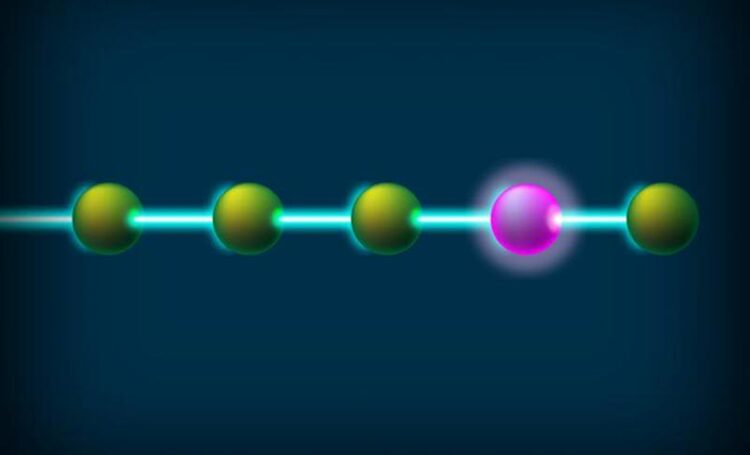A new way to erase quantum computer errors

While errors are normally hard to spot in quantum devices, researchers have shown that, with careful control, some errors can cause atoms to glow. Researchers used this capability to execute a quantum simulation using an array of atoms and a laser beam, as shown in this artist's concept. The experiment showed that they could discard the glowing, erroneous atoms and make the quantum simulation run more efficiently.
Credit: Caltech/Lance Hayashida
Researchers have made the first demonstrations of identifying and removing “erasure” errors.
Quantum computers of the future hold promise in solving all sorts of problems. For example, they could lead to more sustainable materials, new medicines, and even crack the hardest problems in fundamental physics. But compared to classical computers in use today, rudimentary quantum computers are more prone to errors. Wouldn’t it be nice if researchers could just take out a special quantum eraser and get rid of the mistakes?
Reporting in the journal Nature, a group of researchers led by Caltech is among the first to demonstrate a type of quantum eraser. The physicists show that they can pinpoint and correct for mistakes in quantum computing systems known as “erasure” errors.
“It’s normally very hard to detect errors in quantum computers, because just the act of looking for errors causes more to occur,” says Adam Shaw, co-lead author of the new study and a graduate student in the laboratory of Manuel Endres, a professor of physics at Caltech. “But we show that with some careful control, we can precisely locate and erase certain errors without consequence, which is where the name erasure comes from.”
Quantum computers are based on the laws of physics that govern the subatomic realm, such as entanglement, a phenomenon in which particles remain connected to and mimic each other without being in direct contact. In the new study, the researchers focused on a type of quantum-computing platform that uses arrays of neutral atoms, or atoms without a charge. Specifically, they manipulated individual alkaline-earth neutral atoms confined inside “tweezers” made of laser light. The atoms were excited to high-energy states—or “Rydberg” states—in which neighboring atoms start interacting.
“The atoms in our quantum system talk to each other and generate entanglement,” explains Pascal Scholl, the other co-lead author of the study and a former postdoctoral scholar at Caltech now working at a quantum computing company in France called PASQAL.
Entanglement is what allows quantum computers to outperform classical computers. “However, nature doesn’t like to remain in these quantum entangled states,” Scholl explains. “Eventually, an error happens, which breaks the entire quantum state. These entangled states can be thought of as baskets full of apples, where the atoms are the apples. With time, some apples will start to rot, and if these apples are not removed from the basket and replaced by fresh ones, all the apples will rapidly become rotten. It is not clear how to fully prevent these errors from happening, so the only viable option nowadays is to detect and correct them.”
The new error-catching system is designed in such a way that erroneous atoms fluoresce, or light up, when hit with a laser. “We have images of the glowing atoms that tell us where the errors are, so we can either leave them out of the final statistics or apply additional laser pulses to actively correct them,” Scholl says.
The theory for implementing erasure detection in neutral atom systems was first developed by Jeff Thompson, a professor of electrical and computer engineering at Princeton University, and his colleagues. That team also recently reported demonstrating the technique in the journal Nature.
By removing and locating errors in their Rydberg atom system, the Caltech team says that they can improve the overall rate of entanglement, or fidelity. In the new study, the team reports that only one in 1,000 pairs of atoms failed to become entangled. That’s a factor-of-10 improvement over what was achieved previously and is the highest-ever observed entanglement rate in this type of system.
Ultimately, these results bode well for quantum computing platforms that use Rydberg neutral atom arrays. “Neutral atoms are the most scalable type of quantum computer, but they didn’t have high-entanglement fidelities until now,” says Shaw.
The new Nature study titled “Erasure conversion in a high-fidelity Rydberg quantum simulator,” was funded by the National Science Foundation (NSF) via the Institute for Quantum Information and Matter, or IQIM, based at Caltech; the Defense Advanced Research Projects Agency; an NSF CAREER award; the Air Force Office of Scientific Research; the NSF Quantum Leap Challenge Institutes; the Department of Energy’s Quantum Systems Accelerator; a Taiwan–Caltech Fellowship; and a Troesh postdoctoral fellowship. Other Caltech-affiliated authors include graduate student Richard Bing-Shiun Tsai; Ran Finkelstein, Troesh Postdoctoral Scholar Research Associate in Physics; and former postdoc Joonhee Choi, now a professor atStanford University.
Media Contact
Whitney Clavin
California Institute of Technology
wclavin@caltech.edu
Office: 626-395-1944
All latest news from the category: Information Technology
Here you can find a summary of innovations in the fields of information and data processing and up-to-date developments on IT equipment and hardware.
This area covers topics such as IT services, IT architectures, IT management and telecommunications.
Newest articles

Innovative 3D printed scaffolds offer new hope for bone healing
Researchers at the Institute for Bioengineering of Catalonia have developed novel 3D printed PLA-CaP scaffolds that promote blood vessel formation, ensuring better healing and regeneration of bone tissue. Bone is…

The surprising role of gut infection in Alzheimer’s disease
ASU- and Banner Alzheimer’s Institute-led study implicates link between a common virus and the disease, which travels from the gut to the brain and may be a target for antiviral…

Molecular gardening: New enzymes discovered for protein modification pruning
How deubiquitinases USP53 and USP54 cleave long polyubiquitin chains and how the former is linked to liver disease in children. Deubiquitinases (DUBs) are enzymes used by cells to trim protein…



